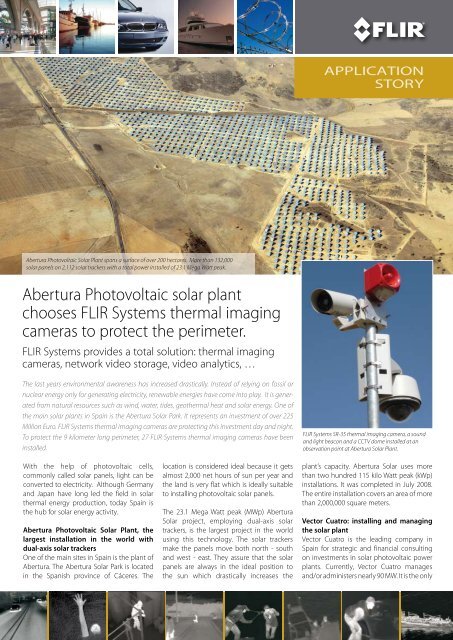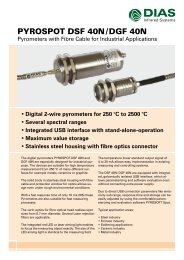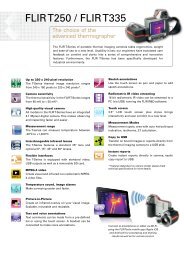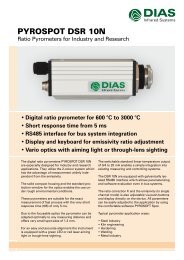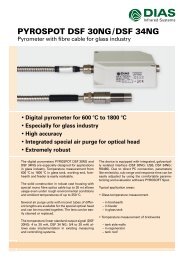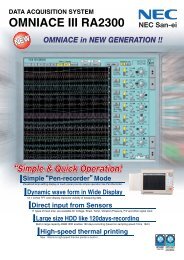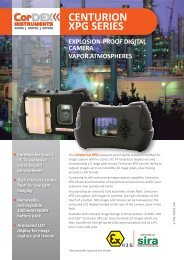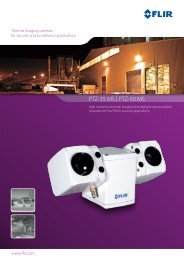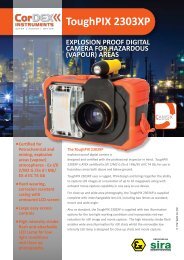Abertura photovoltaic solar plant - Test Equipment Depot
Abertura photovoltaic solar plant - Test Equipment Depot
Abertura photovoltaic solar plant - Test Equipment Depot
Create successful ePaper yourself
Turn your PDF publications into a flip-book with our unique Google optimized e-Paper software.
est security option. The other <strong>plant</strong>s aremanaged by Vector Cuatro after the securitysystem was decided and contracted”.Comparing CCTV, fences, walking patrolsand thermal imaging“We looked at several possibilities.Conventional CCTV with lighting or infraredilluminators, walking patrols, passive IRbarriers and thermal imaging cameras. Aftercareful evaluation of each option, we havechosen for thermal imaging cameras formultiple reasons.""The entire perimeter around the <strong>plant</strong> cannot be lit up. This is far too intrusive for thearea in which the <strong>solar</strong> <strong>plant</strong> is located.Installing and maintaining light is also anexpensive exercise. It also uses a lot ofpower.”“Infrared illuminators are also expensive.Furthermore, infrared illumination is notoffering the same range performance asthermal imaging cameras at all. This meansthat more cameras need to be installed andmore civil works need to be carried out.”“Although we have a fence around the entireperimeter, this is not the best solution either.The fence is relatively weak since we need tohave large holes in it so that animals can getthrough it. But even if the fence would bestronger, we would need to install detectorsin it. In order to see if an alarm is false ornot, a CCTV system with lights and infraredilluminators needs to be installed anyhow.”“Finally we looked at patrolling the area.But apart from the fact that guards are acostly exercise, we defined another moreunexpected problem. <strong>Abertura</strong> is a sandylocation where a lot of dust can be produced.Patrolling the entire area means that theguards would need to drive around in a carduring the night as well. By doing this theywould produce a lot of dust. This seems tobe not important, but it is. In order to keepthe <strong>solar</strong> panels as effective as possible, weneed to remove the dust from them. Nowwe do this twice a year. Each cleaning costsabout 100, 000 Euro. We estimated that if wehave the area patrolled during the night, weneed one extra cleaning per year.”FLIR Systems thermal imaging cameras:low Total Cost of Ownership“I got in contact with Mr. Esteban Ces ofSoviter, a FLIR Systems distributor in Spain.He explained me the concept of the thermalfence and the advantages of using a videoanalytics solution based on thermal imagingcameras. After a thorough calculation ofinstallation cost, and even more important,of the Total Cost of Ownership, we decidedto go for this option.”“To protect the 9 kilometer perimeter we haveinstalled 27 FLIR Systems thermal imagingcameras: two VSR-6, six SR-19, five SR-35 andtwelve SR-50 are creating a thermal fencearound the <strong>solar</strong> <strong>plant</strong>. Two FLIR SystemsSR-100 thermal imaging cameras, mountedon a pan/tilt were installed separately as anaddition to this thermal fence. Vector Cuatroalso ordered two spare units that can beinstalled if something should go wrong withone of the thermal cameras. So far, thereIn the control room, a PC running FLIR Sensors Managersoftware shows the images of all cameras. FLIR SensorsManager contains a lot of useful features for managingsecurity networks. FLIR Sensors Manager is used to setup the video analytics that are being run on the VideoProcessing Units. They analyze video streams from thenetwork and generate alarms when rules are triggered.has been no need to use them.”, explainsEsteban Ces of Soviter.FLIR Systems hardware and software“We have chosen not only for FLIR Systemsthermal imaging cameras, but a lot of theother material we needed is from FLIRSystems as well. FLIR Networked Systems,a separate division within FLIR Systems,provided us Mini Servers, input/outputboxes, video processing units and NetworkDigital Video Recorders. The software usedto manage the entire systems is FLIR SensorsManager. This out-of-the-box softwareallows for easy installing and managing FLIRSystems thermal imaging cameras and othersensors in a TCP/IP network.”The thermal fence“The principle of the thermal fence is quitesimple. All cameras are installed along theperimeter. Using the FLIR Sensors Managersoftware we define “trip wires”, a videoanalytics algorithm, to detect if someone istrying to intrude the perimeter. If someonecrosses a line, which we have set in the videoanalytics, an alarm will go off. A light will startto flash and an acoustic alarm will go off aswell. The operator will immediately see theimage on his screen of the camera that hascreated the alarm. He can then determine ifit is a false alarm, created by e.g. an animalor not. If it is a real alarm and the intruder isnot scared away by the light and sound, theoperator will call the police which can be onthe scene within minutes.”A rack in the control room converts the Fiber optic toEthernet. It also contains the FLIR Systems Video ProcessingUnits and the FLIR Systems Network DigitalVideo Recorders.Installing the thermal fence“Along the perimeter 25 observation postsare installed. An observation post consistsof a fixed mounted FLIR Systems thermalimaging camera that is covering a certainpart of the perimeter, a light/sound beaconand in some cases a CCTV camera that caneventually be used during daylight.”“At each observation post an electricalcabinet is installed. The video and data of
applicationstor yA part of the <strong>Abertura</strong> Solar Power <strong>plant</strong>.the thermal imaging camera and the CCTVcamera are transferred to a FLIR Mini Server.The beacon is also connected to the FLIR MiniServer over a FLIR input/output (I/O) box.All signals are converted by the Mini Serverto TCP/IP. Thanks to an Ethernet to fiberoptics converter all signals are transferredover long distance to the control room. Atthis control room the data is put on a TCP/IPnetwork again with a fiber optics to Ethernetconverter.”“On the same Local Area Network (LAN) acomputer is connected. It runs FLIR SensorsManager and displays the images of thethermal cameras. It also allows setting thenecessary rules for the alarms. These rules aresent to FLIR Systems Video Processing Units.They are constantly analyzing the thermalimages coming from the cameras. If theydetect an anomaly, the Video ProcessingUnits will send a signal to the observationpost that is generating the alarm. The MiniServer will send a signal to the I/O box. Acontact will close and a sound/light alarmwill go off. At the same time the operator willget the image of the camera that provokedthe alarm on his screen so that he can takethe necessary action.”“Finally, in the control room, FLIR SystemsnDVRs are connected to the LAN. They arecontinuously recording all images of allthermal imaging cameras. They have thecapacity to store all the images during 15days. Afterwards they overwrite the data.”“The combination of the FLIR Systemsthermal imaging cameras and the videoanalytics all managed by FLIR SensorsManager is perfect. During the night thereis great thermal contrast between theenvironment and a potential intruder whichFLIR Sensors Manager contains video analytics algorithmslike Trip Wire. An alarm will go off if someone crosses theline set by the operator.means that we only need two or threepixels to detect something. This meansthat we can detect potential intruders atan extremely far distance away. In fact,thermal imaging cameras provide muchmore information to video analytics thanCCTV cameras.”Thermal imaging, the preferred solution“We are extremely happy with the thermalfence.”, says Mr. Escalada. “Not only is it acost effective solution due to the fact thatwe did not need to do huge civil worksand that we are not consuming a lot ofelectricity, it is very effective as well. If Icompare this security installation with theones we have at other <strong>solar</strong> <strong>plant</strong>s we aremanaging, I can only say it beats them all.We have practically no false alarms and areable to protect the entire perimeter withjust one operator.”FLIR nDVRVideoControl RoomTCP/IPAlarmsVideoConfigurationdataVideo/AlarmsFLIR VideoProcessing UnitPC withFLIR Sensors Manager“For future <strong>solar</strong> <strong>plant</strong>s that still need tobe constructed, we will definitely choosethe same solution. And when the securitysystem in existing <strong>solar</strong> <strong>plant</strong>s needs to bereplaced, it will be replaced by a thermalsolution as well.”, concludes Mr. Escalada.Fiber Optic toEthernet converterObservationpoint 2Observationpoint 3Observationpoint nFiber Optic CableFiber Optic CableFiber Optic CableEthernet/Fiberoptic converterSchematical overview of the installed thermal fence at <strong>Abertura</strong>.Fiber optic cableto control roomFLIR Mini ServerElectrical cabinetObservation point 1FLIR I/O boxVideoand dataLight andSound beaconFLIR ThermalcameraCCTV cameraIf you would like more informationabout FLIR Systems thermal imagingcameras or about any of the productsof FLIR Networked Systems suchas Mini Servers, VPUs, nDVRs, FLIRSensors Manager or if you want moreinformation about this application,please contact:FLIR Commercial Vision Systems B.V.Charles Petitweg 214847 NW Breda - NetherlandsPhone : +31 (0) 765 79 41 94Fax : +31 (0) 765 79 41 99e-mail : flir@flir.comwww.flir.comAS_0309_0029_EN


